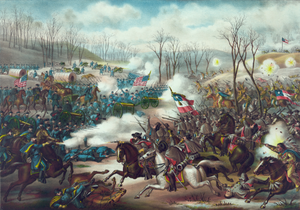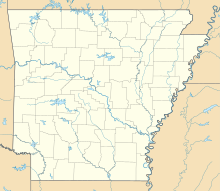Battle of Elkhorn Tavern
| Battle of Pea Ridge Battle of Elkhorn Tavern |
|||||||
|---|---|---|---|---|---|---|---|
| Part of the American Civil War | |||||||
 The Battle of Pea Ridge, Ark. by Kurz and Allison |
|||||||
|
|||||||
| Belligerents | |||||||
|
|
|
||||||
| Commanders and leaders | |||||||
|
|
|
||||||
| Units involved | |||||||
| Army of the Southwest | Trans-Mississippi District | ||||||
| Strength | |||||||
| 10,500 | 16,500 | ||||||
| Casualties and losses | |||||||
| 1,384 | 2,000 | ||||||
|
|
|||||||
The Battle of Pea Ridge (March 7 – 8, 1862), also known as the Battle of Elkhorn Tavern, was a battle of the American Civil War. It was fought at Pea Ridge in northwest Arkansas, near Leetown. United States forces, led by Brigadier-General Samuel R. Curtis, moved south from central Missouri, driving Confederate forces into northwestern Arkansas. Major-General Earl Van Dorn launched a Confederate counter-offensive, hoping to recapture northern Arkansas and Missouri. Curtis held off the Confederate attack on the first day and drove Van Dorn's force off the field on the second. This civil war battle, one of the few in which a Confederate army outnumbered its opponent, essentially established Federal control of most of Missouri and northern Arkansas.
United States forces in Missouri during the latter part of 1861 and early 1862 had pushed the Confederate Missouri State Guard under Major-General Sterling Price out of the state. By spring 1862, Federal Brig. Gen. Samuel R. Curtis determined to pursue the Confederates into Arkansas with his Army of the Southwest.
Curtis moved his approximately 10,250 Federal soldiers and 50 artillery pieces into Benton County, Arkansas, and along Little Sugar Creek. The Federal forces consisted primarily of soldiers from Iowa, Indiana, Illinois, Missouri, and Ohio. Over half of the Union soldiers were German immigrants, grouped into the 1st and 2nd Divisions, which were under the command of Brig. Gen. Franz Sigel, himself a German immigrant. Upon learning that General Curtis would command the army instead of himself, Sigel threatened to resign, so the predominantly native-born regiments were assigned to the 3rd and 4th divisions to create an ethnic balance among divisions and their commanders.
...
Wikipedia


